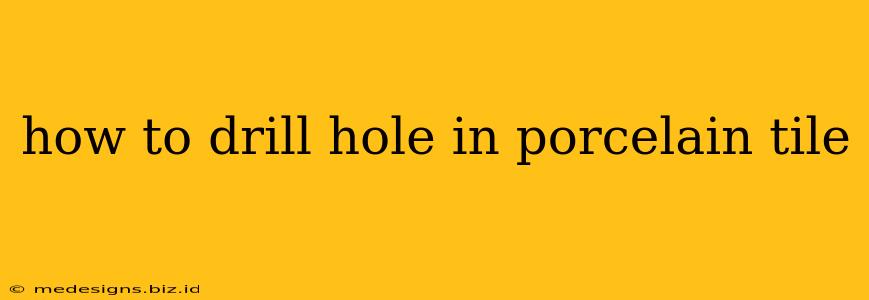Drilling a hole in porcelain tile might seem daunting, but with the right tools and techniques, it's a manageable DIY project. Porcelain is incredibly hard and prone to cracking, so precision and the right approach are crucial. This guide will walk you through the process, ensuring a clean hole every time.
Essential Tools for Drilling Porcelain Tile
Before you begin, gather the necessary tools. Improper tools can lead to cracked tiles and frustration. Here's what you'll need:
- A quality carbide-tipped masonry bit: This is the most important tool. Standard drill bits will simply shatter on porcelain. Look for bits specifically designed for tile and masonry. The size of the bit depends on the size of the hole you need.
- Slow-speed drill: A drill with variable speed settings is ideal. You'll need to drill slowly and steadily to avoid cracking the tile. A powerful hammer drill is not recommended.
- Masking tape: This helps prevent the bit from slipping and chipping the tile.
- Safety glasses: Always protect your eyes when working with power tools.
- Pencil: To mark the drilling location accurately.
- Clamp (optional): If working on a loose tile, a clamp will help secure it during drilling.
- Cooling lubricant (optional but recommended): Water or a specialized tile lubricant helps keep the bit cool and prevents cracking. A spray bottle is useful for this.
Step-by-Step Guide: Drilling Through Porcelain Tile
Follow these steps carefully for successful hole drilling:
-
Mark the Drilling Location: Use a pencil to mark the exact center of where you want the hole. Accuracy is key here.
-
Secure the Tile: If the tile is loose, clamp it securely to a stable surface to prevent movement during drilling.
-
Apply Masking Tape: Apply a piece of masking tape over the marked area. This will help the drill bit stay in place and prevent slippage. Multiple layers are beneficial.
-
Start Drilling: Use a slow speed (around 500-800 RPM) and apply light pressure. Let the bit do the work. Avoid pressing too hard, as this can cause the tile to crack.
-
Cool the Bit: Regularly apply water or lubricant to the bit to keep it cool and prevent overheating. Overheating is a major cause of cracked tiles.
-
Maintain Consistent Pressure: Keep the pressure even and consistent throughout the drilling process. Avoid applying pressure in sudden bursts.
-
Drill Slowly and Carefully: Patience is paramount. Take your time and proceed slowly and steadily. Rushing the process significantly increases the risk of cracking the tile.
-
Finish the Hole: Once the bit has passed through the tile, you can usually increase the speed slightly to complete the hole.
Troubleshooting Common Problems
- Cracked Tile: This is usually caused by applying too much pressure, using a high speed, or overheating the bit. Always use a carbide-tipped bit and plenty of coolant.
- Bit Slipping: This is often due to insufficient masking tape or a dull bit. Make sure to use plenty of tape and replace dull bits.
- Uneven Hole: This may result from inconsistent pressure or an unsteady hand. Practice on a scrap tile before drilling into your finished piece.
Choosing the Right Bit for the Job
The type of bit greatly impacts your success. Carbide-tipped masonry bits are designed to handle the hardness of porcelain, but even within that category, there are variations:
- Standard Carbide Tip: Suitable for most drilling tasks.
- Diamond-Tipped Bits: Offer even greater durability and longevity, especially for multiple holes or thicker tiles.
By following these steps and using the correct tools, you'll be able to drill holes in porcelain tile with confidence and precision. Remember, patience and a slow, steady approach are crucial for a successful outcome!
